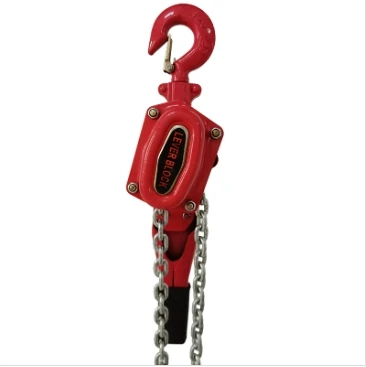


Understanding Lever Blocks An Essential Tool for Lifting and Rigging
In the world of lifting and rigging, lever blocks have become indispensable tools, making lifting operations safer, more efficient, and less labor-intensive. Lever blocks, also known as lever hoists, are portable devices that use a lever mechanism to lift heavy items with minimal physical exertion. This article will explore the functionality, applications, advantages, and safety considerations associated with lever blocks.
What is a Lever Block?
A lever block is a type of manual hoisting device. It typically consists of a hand-operated lever that engages a ratchet mechanism. When the lever is pulled down, it activates a series of gears that lift a load attached to a hook. The simple design allows the user to lift heavy objects using minimal force, making it particularly valuable in various industrial and construction applications.
How Does it Work?
The operation of a lever block is based on mechanical advantage. The lever arm multiplies the force applied by the user, enabling the lifting of heavy loads with less physical effort. The ratchet mechanism locks the load in place once it is lifted, ensuring safety during operation. Most lever blocks have adjustable hooks for easy attachment to different load configurations and come in several weight capacities, typically ranging from 0.5 tons to several tons.
Applications of Lever Blocks
Lever blocks are versatile tools used across a plethora of industries
. In construction, they assist in lifting scaffolding, precast concrete, and other heavy materials. In manufacturing, they are employed for appropriately positioning machinery or structural components. Additionally, lever blocks are essential in warehouses for moving heavy pallets or crates. Beyond industrial usage, they are also useful in outdoor applications, such as recreational activities like tree work or lifting boats.Advantages of Using Lever Blocks
1. Compact and Portable Lever blocks are generally lightweight and easy to carry, making them ideal for job sites with limited space. Their portability allows workers to transport them easily from one task to another.

2. Manual Operation Since lever blocks operate manually, they do not require electrical power or batteries. This makes them suitable for outdoor use, where power sources may be scarce.
3. Cost-Effective Lever blocks are typically more affordable than electric hoists or cranes, making them accessible for small businesses and individual users.
4. Ease of Use The intuitive design of the lever block means even inexperienced users can learn to operate them with minimal training. With a little practice, lifting and adjusting loads can be accomplished efficiently.
5. Safety Lever blocks are engineered with safety features such as a load brake and a durable hook to prevent accidental release of heavy loads. Additionally, the manual operation allows for greater control during lifting.
Safety Considerations
Despite their advantages, safety remains a priority when using lever blocks. Here are essential safety tips to ensure safe operation
- Inspect Regularly Before each use, inspect the lever block for any signs of wear, such as frayed cables or damaged hooks. - Follow Load Ratings Always be aware of the load capacity of the lever block and avoid exceeding it, as this can lead to equipment failure and accidents. - Use Proper Techniques Training on how to use the lever block effectively will ensure workers apply the correct techniques, preventing injuries. - Secure Anchor Points Ensure that the lever block is attached to secure and stable anchor points to prevent slips or falls during operation.
Conclusion
In summary, lever blocks are vital tools that enhance efficiency and safety in lifting operations across various industries. Their mechanical advantage, coupled with ease of use, makes them essential for heavy lifting tasks. However, like any lifting equipment, proper care, regular inspections, and adherence to safety protocols are vital in maintaining safe and efficient operations. By understanding the benefits and employing safe practices, users can make the most out of this invaluable tool in their daily operations.



